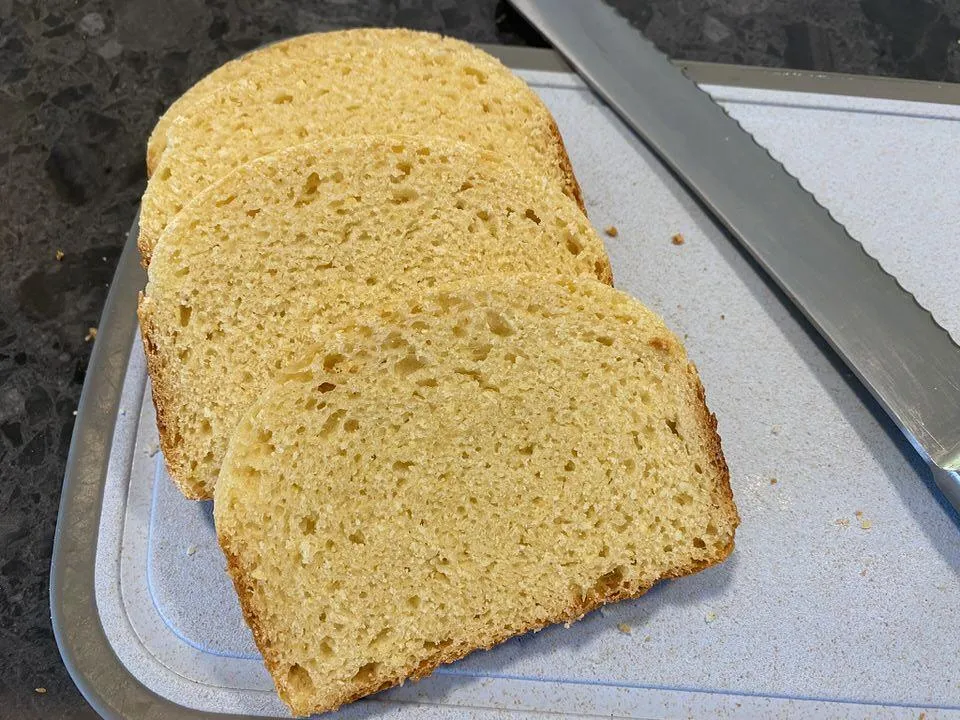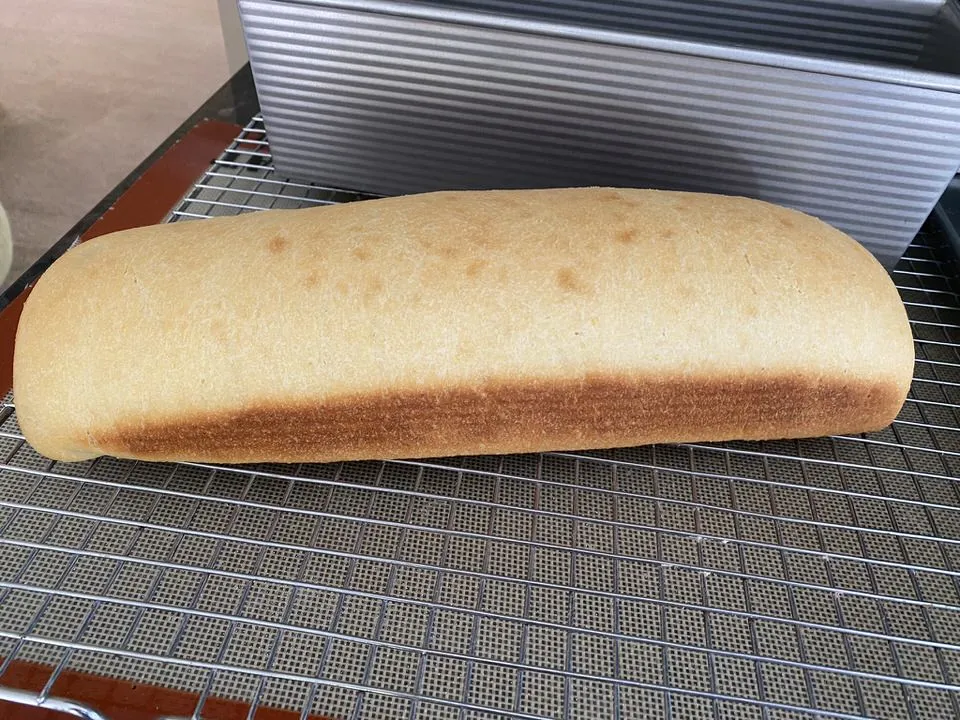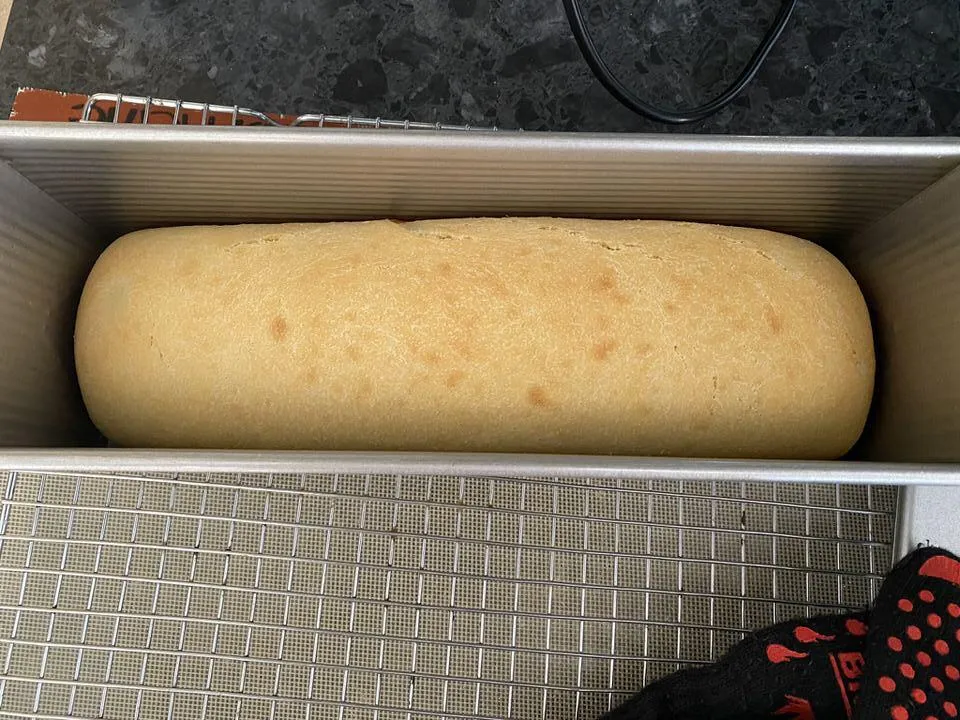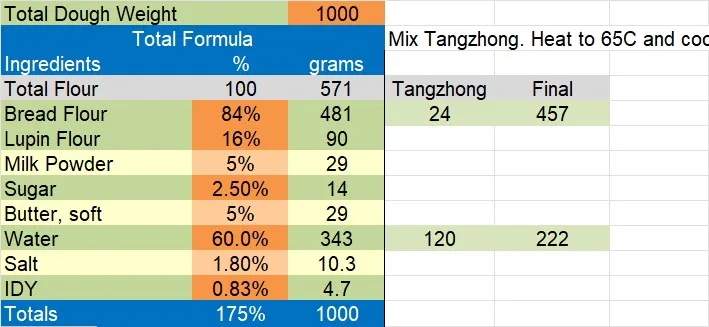
Bread Evaluation Notes - Advice welcome.
Pullman Sandwich loaf with 16% lupin flour
Date Baked: 16th April 2023.
Tangzong method adopted (5% bread flour)
Weight against Volume
I mixed 1000-gram dough @ 60% hydration. The dough was very tight, and I should have added extra water but didn’t. It became more pliable and softer during the bulk fermentation and shaping.
The dough colour was pale yellow like custard. I intended to place into a 330-mm (13”) Pullman pan. I shaped the dough into a blunt cylinder suitable to the Pullman pan. The dough only raised about 1/3 height of the pan. I extended the final proof from 90 minutes to 120 minutes, but I was worried it would over proof.
Taste
The baked loaf had a long lingering finish. With a smooth mouthfeel and a slightly nutty flavour. The crumb was a pale-yellow colour with a nice sandwich density, not heavy or gummy. The aroma was sweet.
My chief tester and critic are my wife who liked the taste and picked up the nutty flavour introduced by the lupin flour. We tried it fresh, toasted and with an aged vintage cheddar.
I would I bake this again.
Suggested improvements for next bake:
Increase the hydration. Use a fresh sachet of IDY. Investigate appropriate dough to pan size for this formula.



- gavinc's Blog
- Log in or register to post comments
Liking the taste is a great starting point, Gavin. Instead of sacrificing gluten for a Tangzhong, you could try cooking or soaking 5% lupin flour instead, and incorporating it into the dough after developing the gluten. Might get you a little more lift. I look forward to experimenting with it myself.
Best Baking,
dw
Thanks, Debra. I shall take on your suggestion. I like the challenge of getting on top of this; a feeling of Déjà vu thinking back to my first attempt at your 100% whole-wheat sandwich loaf. Derek used the lupin flour in a tangzhong but didn't get it form a paste.
Thought: my bakers flour is 11.5% protein, so I was thinking of bumping it up with some VWG. Is my idea valid?
I'm looking forward to you having a play with the lupin flour.
Cheers,
Gavin
I had never heard of Lupin flour and now after looking it up it sounds worth trying. What size Pullman pan did you use? I would definitely update your formula and increase the overall dough weight. I would try increasing your yeast amount as well. You want the dough to almost rise to the top of the pan before baking.
I’m look forward to seeing your further experiments with this flour.
Ian
Thanks, Ian. My Pullman pan is 330mm (13"). I thought about increasing the dough, but my other loaf recipes work great at 900-gram to 1kg. I'll keep it in mind if I continue to get a poor rise. I usually let the dough rise to within 1.25cm of the top and then slide the lid on, but on this occasion it barely made it 1/3 way up.
Gavin
IMO i'd have increased the hydration and used a smaller loaf pan.
You've got lupin flour, milk powder and butter so crumb is as expected. Curious that the crust isn't darker with the milk powder and sugar.
Perhaps tangzhong the lupin flour instead of the gluten flour. Instead of milk powder you could use milk for the tangzhong. Just throwing out ideas here.
Hi Abe. Thanks for your thoughts. I'll definitely increase the hydration for next bake. DW has suggested to cook or soak the lupin flour also., so I will take on that suggestion.
I like the challenge of problem solving this.
Gavin
Yes i did treat the Lupin flour to the Tangzhong procedure of 5 x water to 1 lupin flour and bring to the boil It doesnt have the starch to gelatienize so it doesn't thicken although it did look like custard and i then put it in the fridge as i wasnt ready to use it . A couple of days later i did use it and zapped it in the microwave to warm it up and it worked well.
i think you said this was a tight dough and i think it does need to be a bit slack.
i have made a sour dough version today pushing up to 30% lupin flour and that dough was tighter than i would have preferred.
i also made some crackers. using some of the sour dough culture and white flour. in my haste i forgot the salt in the cracker dough and sprinkled some on one of the trays.
kind regards Derek
Yes, I remember your comment about cooking the lupin and it not developing into a paste. DW also suggested that is what I should do, so I did it today with my 2nd test bake. Interesting about your sourdough being a bit stiff. I think that will be my next venture to bake a sourdough with the lupin flour. I'll probably start with 10% and increase my usual hydration to compensate. I'm enjoying the challenges that the lupin flour is throwing up. I love the flavour that it imparts so far and my chief tester likes also.
Cheers,
Gavin.
This bread looks and sounds super, Gavin. I haven't worked with bean flours of any kind but find these posts (yours and Derek's and JonJ's) interesting. I'm over-run with flour at present, but when a bin opens up, I'll probably try this with the suggested changes. Thanks for the post!
AG We are looking forward to Debra Winks versions coming soon.
regards Derek
Intriguing especially with the same characters involved following the Red Wheat quest with Interstate and Cross Continent involvement with Jon J drawing attention to an article in a South African farm journal and me then chasing it up finding the actual farmer here in Western Australia and eventually another famer in Victoria along with Debra's sound advice guiding Gavin to his Holy Grail the wholewheat sandwhich loaf.
And now another Great West Australian enterprise doing great stuff with a legume that had been of most value as an alternative planting in crop rotation and helping with Nitrogen fixing in the soil and a valuable stock feed. Its now being recognised for its great health benefits for Humans.
I remember The Great Red Wheat Quest! That was exciting and kind of amazing when you think about it, the way it pulled together. Must have been such fun for you! And the baked loaves looked so worth it!! Three or four continents represented? A truly global forum we have here.
Jon was explaining on another thread that the lupin flours we can get in the States may or may not have the same sweet undertones as the Australian flours, due to varietal differences. I don't mind experimenting with a few brands; it just has to wait until I use up some of my existing stock. In the meantime, I'll enjoy seeing what you, Gavin and Jon are baking. Gavin's last bake looked terrific, didn't it?
You know what AG, I've been trawling Amazon and this flour has got "sweet" in the name, might be worth a go: https://www.amazon.com/Sweet-White-Lupin-Bean-Flour/dp/B07TBPD5F5/
Two interesting things there, the first is that its out of stock, the second being that they didn't name the variety of lupin used and we know its preferable to use to use proper nomenculture rather than just a common name,
Attached is an interesting publication put out by Pulse Australia on Australian Sweet Lupins that does name the varieties and well worth a read . It lists the varieties of lupin in the different categories Albus Lupin and Angustifolius Australian Sweet Lupin, the list shows some obviously new varieties that have PBA which is Plant Breeder Australia where royalties and restrictions on seed apply.
https://www.pulseaus.com.au/growing-pulses/bmp/lupin#variety-selection
When i was trying to find out as much information as i could about Red winter wheat grown here in Australia i became aware of plant breeder rights and how they apply to growers and its quite an interesting subject in itself..
A classic example of nomenculture being important was when i was keeping Birds (Aviculture) there was a claim made by a government department that a BLACKBIRD that is not known to be in Western Australia but does exist in other Eastern states was detected located and destroyed by one of its officers. at a small country town of Nannup, a beautiful little country town in our picturesque Southwest a former Timber milling town miles from other small towns in the Region. The part of the report that got my attention was that it was inferred that the BLACKBIRD Turdus Merula was an escapee from Aviculture. i followed up this report and it became quite a story. Apparently the bird was detected by a person conducting a bird tour of the southwest region of Western Australia where we have some very unique and beautiful Parrots. The bird was not able to be visually spotted by many experienced twitchers eyes but recognised by its call. Although there were Europeans on the bus and familiar with the call of Turdus Merula they certainly were not familiar with our native birds calls!
The Government Department was notified and an officer was sent out from a town 46.5 kilometres away and a 37minute road trip . The person reporting the BLACKBIRD had moved on with their bus load of bird enthusiast but the officer was able to find the exact same location and obviously sight the bird which the enthusiasts many from overseas and really keen spotters hadn't managed to do! The officer was then able to despatch the BLACKBIRD bird with a shotgun. With the speed of Government departments id doubt if the officer would have been there within the hour!
i was a little bit sceptical that the poor bird had stayed in that one location for such an extended period. I was informed that the birds remains had been sent to a government lab for Identification i followed that up and found that the lab had indeed been sent some birds to examine and that there were indeed some BLACKBIRDS or parts thereof but hadn't specifically been asked to id Turdus Merula.and what they received was a very mixed bag of several shot blasted BLACK BIRDS Even our swans are black here.
i might add that we in Western Australia have been pretty lucky at not having many of the invasive species from Europe that are in the Eastern States Sparrows,Starlings, Thrushes and indeed Blackbirds due mostly to a formidable barrier known as the Nullabour Plain
https://www.australia.com/en/trips-and-itineraries/perth-and-surrounds/crossing-the-nullarbor.html
Anyway the moral of the story being the nomenculture is very important especially when very common terms are used such as Black or Sweet
Very interesting post Derek, I enjoyed reading it. You must of been up early!
Cheers,
Gavin
Yes wide awake at 4am good thing though the brain is usually into gear at that time too.
Great story about the poor birds, and it illustrates a valid point. Just as every black bird isn't a blackbird, I'll have to hope that whatever is in my bag of "sweet lupin flour" isn't bitter. Plenty of reviewers do seem to find some of the lupin flours in the US to be bitter, but so far I've found only a couple of products labeled sweet. Those seem like a good place to start. If I find something that bakes up well and tastes good, I'll be happy. The nutritional benefits seem like they'd be worth some effort, and I'll be glad to have the benefit of these posts before I start. Thanks for all the great info and links.
Hi AG you could always email David about where The Lupin Co who is the agent in the US and Canada he would be happy to hear from you and you can get the info direct from the Horses mouth.
He would be pleased to hear from you
david@thelupinco.com.au
Great idea, Derek! I would like to support him, given the chance.